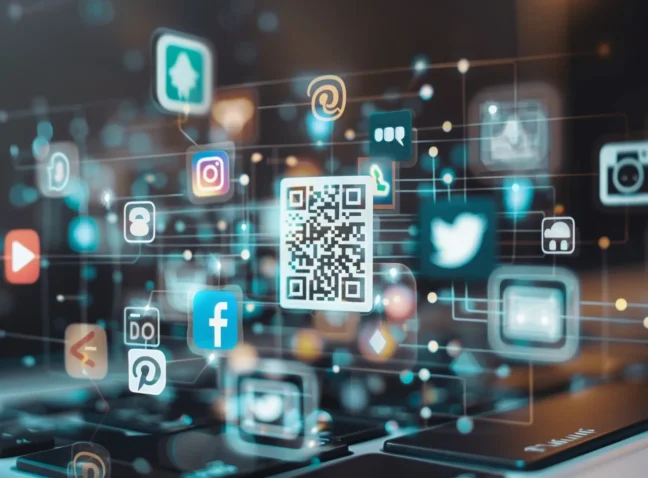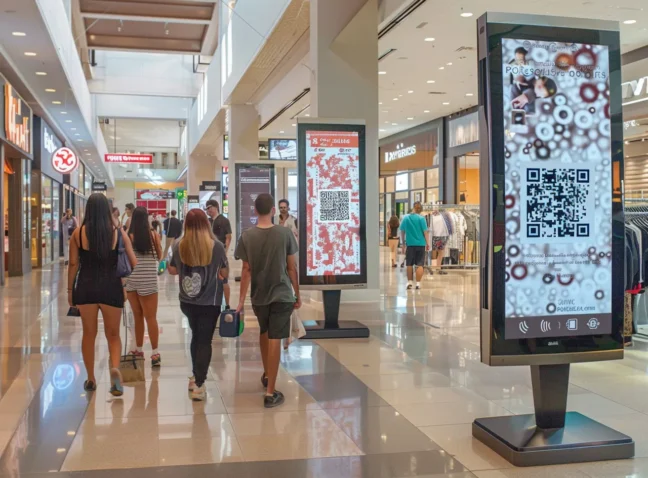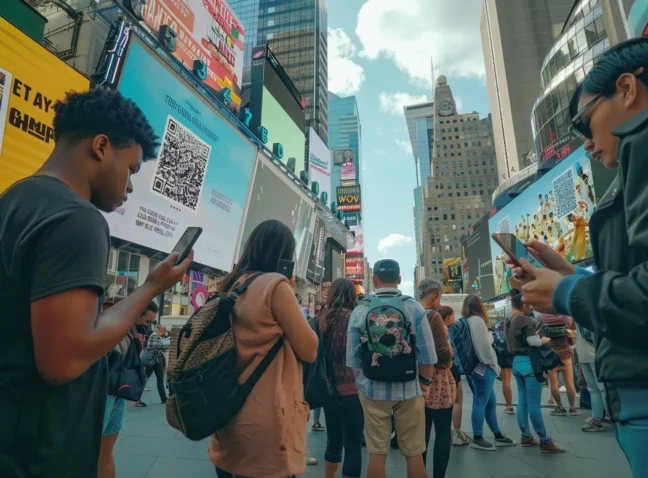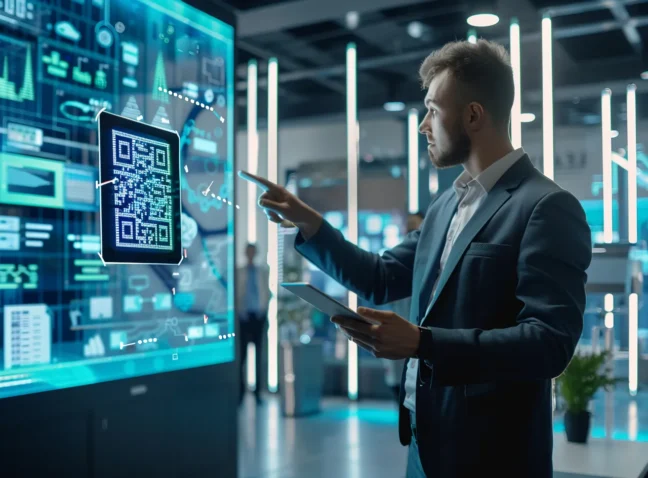Posters have always been a key player in sharing info, showcasing creativity, and inviting folks to learn more. But how do you turn these static images into something more interactive, something that really pulls people in? That’s where QR codes come in handy. These little squares can turn any poster into a doorway to the online world, making it easy for people to dive deeper right from their phones. Suddenly, your poster isn’t just something to look at; it’s a starting point for exploration. Interested in seeing how adding a QR code can take your posters to the next level? Stick around, and let’s discover the magic these codes can bring to your visual messages.
Why Choose QR Codes for Promotional Materials?
In today’s digital landscape, seamlessly blending online and offline marketing is pivotal. QR codes on posters offer a direct pathway to digital content, eliminating barriers like manual URL entry. They transform static posters into interactive experiences, driving engagement and facilitating measurable insights. With dynamic QR codes, adaptability is effortless, ensuring relevance and longevity for your campaigns.
QR Codes for Poster Marketing: Bridging Offline and Online Realms
Incorporating QR codes into posters isn’t just a trend; it’s a strategic move backed by compelling statistics. According to Forbes (2023), 53% of consumers show a higher inclination to engage with posters featuring QR codes. Moreover, Statista (2023) reports a significant 23% increase in QR code scans from 2021 to 2022, indicating a growing familiarity and adoption among audiences.
Additionally, eMarketer (2023) reveals that a whopping 76% of smartphone users have scanned a QR code at least once, underlining the widespread acceptance of this technology. Furthermore, HubSpot’s findings (2023) suggest that 67% of marketers acknowledge QR codes as effective lead generation tools, further validating their utility in marketing campaigns. With MarketWatch (2023) projecting a steady 9.6% annual growth in QR code usage through 2026, it’s evident that QR codes on posters are not just a passing trend but a reliable strategy for enhancing audience engagement and driving results.
Unveiling the Power of QR Codes for Poster Marketing: Ignite Engagement and Elevate Campaign Impact
Incorporating QR codes into placards presents a modern twist to traditional advertising, inviting users into a digital dimension with a simple scan. This integration not only enriches the user experience but also provides a direct pathway to a wealth of additional information, promotions, and interactive content. As these digital gateways blend seamlessly with visual designs, they maintain the aesthetic integrity of the placards while offering a touch of technological sophistication. It’s a strategy that marries the tactile appeal of physical media with the boundless possibilities of the digital world, making every scan a gateway to deeper engagement:
- Recent studies reveal that 53% of consumers demonstrate a greater propensity to interact with placards that feature QR codes. This statistic underscores the growing consumer interest in engaging with content that offers an interactive digital extension, thereby validating the effectiveness of QR codes in capturing and sustaining audience attention.
- The adoption and usage of QR codes have seen a significant uptick, with a notable 23% increase in scans from 2021 to 2022. This trend highlights the expanding role of QR codes in everyday interactions, reflecting their rising popularity and the public’s growing comfort with this technology.
- An impressive 76% of smartphone users have scanned a QR code at least once, illustrating the widespread acceptance and use of this technology among mobile device users. This statistic points to the ubiquity of QR codes and their potential reach among diverse audiences.
- According to marketing professionals, 67% acknowledge the efficacy of QR codes as instrumental in generating leads. This insight emphasizes the strategic value of QR codes in marketing campaigns, highlighting their capability to not only engage but also convert audience interest into actionable outcomes.
- Projections indicate a steady 9.6% annual increase in QR code usage through to 2026, suggesting a sustained growth trajectory for this technology. This forecast points to the enduring relevance and potential of QR codes in the evolving landscape of digital engagement and marketing strategies.
The Risks of Using QR Codes for Advertisements
Despite their numerous benefits, QR codes on posters also come with potential drawbacks. User familiarity and adoption play a crucial role; not all audiences are familiar with QR codes or comfortable using them. This can limit the effectiveness of QR code campaigns in certain demographics or regions. Dependence on technology poses another challenge; the effectiveness of QR codes relies on users having a smartphone with a QR code scanning capability. This technological barrier might exclude segments of the target audience without access to such devices.
Additionally, design challenges can arise; poorly implemented QR codes can detract from the overall poster design, potentially harming brand perception. If the QR code lacks contrast against its background or is too small, it may not scan correctly, frustrating users. Security concerns further compound these issues; users may be wary of scanning QR codes due to potential security risks, such as phishing attacks. Building trust and ensuring the security of the linked content is crucial for successful QR code campaigns.
QR Codes for Promotional Materials: Recognizing Potential Drawbacks
Incorporating QR codes into poster designs has become a popular way to bridge the gap between physical and digital marketing. These codes can instantly direct potential customers to websites, promotions, and more, offering a seamless transition from viewing to engagement. However, this innovative approach is not without its pitfalls. Security concerns, user habits, and design considerations play significant roles in the effectiveness of QR codes on posters. As we delve into these aspects, it’s crucial to weigh the benefits against the potential drawbacks to create a marketing strategy that truly resonates with the audience:
- A considerable majority, over 60% of consumers, harbor reservations about QR codes, fearing that these digital gateways could lead to scams or malicious activities, undermining trust in the brand.
- Despite the widespread availability of smartphones, studies have shown that only a fraction, roughly 20%, of users regularly scan QR codes, indicating a gap between availability and actual usage.
- The success of QR codes is often compromised by issues such as suboptimal placement on posters and the absence of clear instructions, resulting in diminished engagement rates.
- About 40% of consumers report finding QR codes inconvenient, citing the need for a separate application to scan them as a significant barrier to use.
- A notable portion of QR code scans result in users being directed to broken links or content that is not relevant, leading to frustration and potentially harming the brand’s reputation.
QR Codes for Posters: Brands Leveraging Modern Marketing
In today’s digital age, savvy brands are tapping into the potential of QR codes to create more interactive and engaging poster campaigns. This smart integration not only captivates attention but also offers a measurable insight into campaign effectiveness. From fashion powerhouses to the bustling world of entertainment, and from your morning coffee favorites to global awareness initiatives, QR codes are bridging the gap between physical touchpoints and the digital universe. The following examples illustrate how diverse sectors are leveraging this technology to create a seamless consumer journey:
- Retail and Fashion: Industry leaders such as H&M and Uniqlo are revolutionizing window shopping with QR codes in their displays. These codes act as digital gateways, leading customers to exclusive online content, detailed product insights, and personalized offers, thus extending the shopping experience from the physical store to the digital realm.
- Entertainment and Media: The film industry has embraced QR codes to turn movie posters into interactive portals. Scanning a code can transport cinema-goers to watch trailers, secure their seats through ticket booking platforms, or immerse themselves in augmented reality experiences that bring the movie’s world to life.
- Food and Beverage: Giants like Starbucks and McDonald’s are enriching the customer experience with QR codes that do more than just decorate their posters. These codes are keys to unlocking special promotions, new product reveals, or simplifying app downloads, delivering immediate gratification and enhancing customer loyalty.
- Non-Profit and Awareness Campaigns: Organizations committed to causes, such as the World Wildlife Fund, are using QR codes to amplify their message. A quick scan can lead to educational content, stirring narratives, or direct donation pages, thereby magnifying the impact and reach of their campaigns.
These examples and data points vividly illustrate the growing importance of QR codes in crafting modern, engaging, and effective marketing strategies across various industries.
QR code generator for Posters
Thinking about making your billboards more than just big pictures? Pop over to our QR code generator and see how you can turn them into cool, interactive spots. Imagine people stopping to scan and getting taken on a whole new adventure. Let’s dive in and make every billboard scan a fun journey for everyone who sees it.





